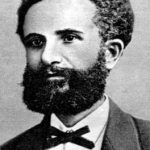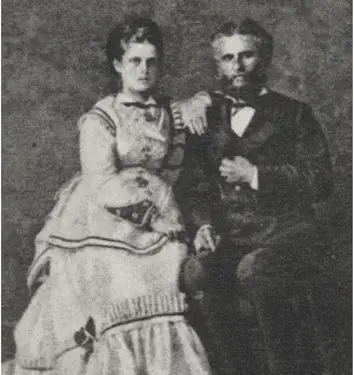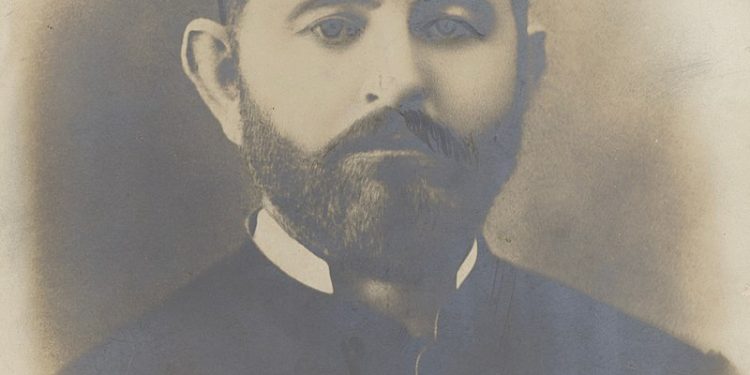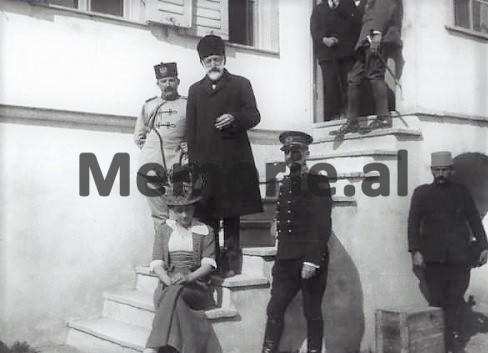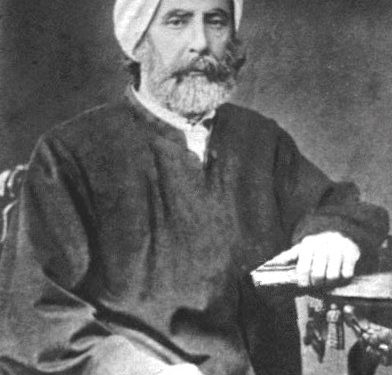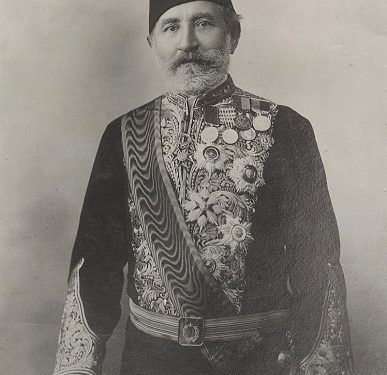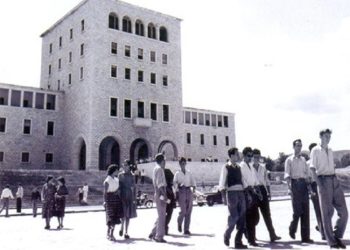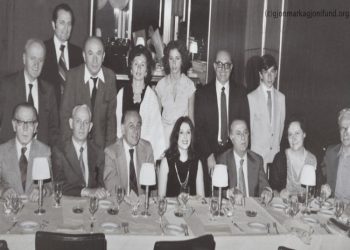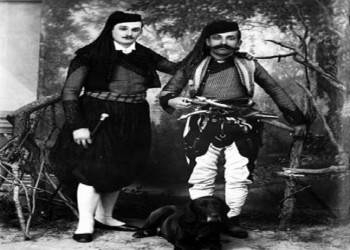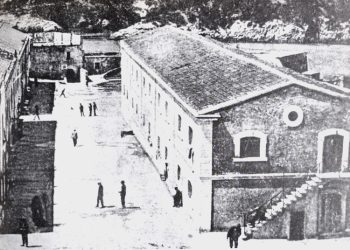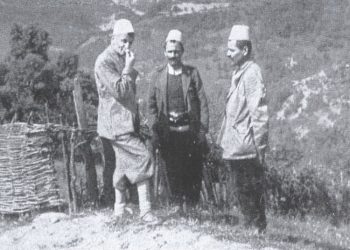Part Two
– THE POLYPHONY OF ARISTOCRATIC ALBANIANISM: THE MULTI-LAYERED TEQE (Bektashi Convent) OF FRASHËR –
Memorie.al / The Teqe of Frashër stood at the forefront of Albanianism, at the head of Albanian teqes from Gjakova in Kosovo, to Durballë in Thessaly, and all the way to Kavala near Thessaloniki! Endless honors and respects to Frashër and the Frashëri family, for the invaluable contribution they made to the altar of the national cause, and for the distinguished people they gave to the National Pantheon, led by the vastly famous Frashëri brothers: Abdyl, Naim, Sami, Mehmet!
Our National Revival figures (Rilindas), when the opportunity and time arose, visited the sophisticated salons of Europe, such as those in Vienna, Rome, Paris, London, Madrid, Moscow, Amsterdam, etc., as was the case with Abdyl Frashëri, Abedin Dino, Mehmet Ali Vrioni, Pashko Vasa, Turhan Pasha Përmeti, and others. We know from history that Dora d’Istria and Faik Konica, from the area of Përmet and its surroundings, were also well “familiarized” with these salons…!
Distinguished members of the Arbëresh intelligence in Italy, the Arbëror of Greece, and even from Albania (Shkodra) – who knew or corresponded with her – dedicated an anthology of poems to the great lady Elena Gjika. In the sophisticated French salons, where the crème de la crème of French intelligence, as well as people from other nations, gathered, there were also (and this should not surprise us) Arbëresh, Albanian, Balkan scholars, etc., some of whom we know and some we do not know at all.
Even to this day, the Ottoman or generally Turco-Mane buildings in Istanbul include a large guest reception salon, perhaps the largest room in the house. This system has been institutionalized for centuries and is inherited best in our days, just like the reception oda (room) in Kosovan towers, and down to Chameria, Monastir, and further. The konaks (large houses/mansions) of Ismail Qemali, an Albanian Rilindas, and Ahmet Refik Pasha, an Ottoman Rilindas, in the Arnaut-Qoy region on the Marmara Sea in Istanbul, were models of these salons; they not only lacked nothing compared to European salons but competed with them both in the space they covered and in their beauty and furnishings.
There, hospitality blended at the highest level with Albanian and Ottoman nobility, the abundance and quality of the menu, and the refinement of the homeowners…! The author of these lines has seen with his own eyes the extremely large salon in Beyoğlu, near the Galatasaray Lyceum, belonging to the Association of Albanians of Istanbul and all of Turkey, as well as an enormous salon of a wealthy Turkish family in Yayla (another region of Istanbul), complete with a piano and other extremely valuable furniture, in our present day…!
The Frashëris and other Albanian Rilindas were followed on their journey from Albania towards the center of the Ottoman Empire, Istanbul, and for some of them, towards Europe. A Naim, Sami, and an Abdyl were followed in their life trajectory from the “salon,” or reception oda of the Nasibi Teqe in Frashër, to the konaks of Istanbul, and Abdyl, the spiritual leader of the League of Prizren, all the way to the sophisticated salons of Paris, Vienna, etc.
But for them, wherever they went, from Frashër to Ioannina, from Ioannina to Istanbul, from Tripoli in Libya to Vienna in Austria, or across Europe, as Abdyl did, the first forge, the simple Teqe of Frashër, remained an indelible memory, where they took the first lessons of Albanianism and Bektashism, of love for humanity, and especially for the Albanian person.
Naim and Sami did not see the Frashër Teqe again, as they were interned and isolated in Istanbul. They died in exile and were buried nearby in Merdiven Köy, in the Bektashi graves near the Sahrai-Cedid mosque. But they had a teqe on the Asian side of Kadıköy, and they never broke contact with the Bektashis and their babas (fathers) (some of whom were Albanian) in their salons. These contacts somewhat reminded them of Frashër and its Bektashi teqe, and helped them not feel the intense heartache for their homeland to a certain extent.
Dearer to their memory than the European or Ottoman salons remained the Albanian ones, and in particular the indelible image, the vision of the Nasibiu Teqe, right there in mountainous Frashër, where they received their first baptism with the ideas of Bektashi mysticism and Albanianism. Naim, Sami, and all the coryphaei of our National Revival were distinguished enlightened figures that illuminated the Albanian people on the path to freedom, independence, and progress. For this, they are immortal, as are they themselves along with the legacy they left us. We cannot deny the influence of the French Enlightenment on them.
But along with it and its indisputable values, we must acknowledge the late Franciscan Father, At Zef Pllumbi, who emphasized that we have a component of the Albanian Enlightenment. Furthermore, according to him, the Bushatllis of Shkodra peacefully carried out transformations half a century before the French Bourgeois Revolution – transformations that the latter carried out with violence. Therefore, the roots of the Albanian Enlightenment, according to Pllumbi, are even older than those of the French one.
In any case, our great Rilindas, with Hoxha Tahsin and the Frashëris at the helm, had both the local and the European components of the Enlightenment interwoven in their formation, and armed with them; they opened the eyes of their people, and on a broader scale, influenced other peoples of the Ottoman Empire with their works. Such was Sami Frashëri, such was Naim Frashëri, and such was Elena Gjika (Dora d’Istria)…!
These Rilindas left indelible traces on their bright path. It is good that they be immortalized, these immortal people not only in Albania but also outside of it, because such is their work, such are the merits and services they have rendered to our people, nation, and homeland. Whenever I go to Istanbul, where I lived for over a decade, I have two sacred places of my own: the madrasa of Hoxha Hasan Tahsini in Cağaloğlu and the building of the Ottoman Ministry of Education in Çemberlitaş, which I never fail to visit, come what may.
It would not be a disaster if, through governmental, institutional channels, our Ministry of Foreign Affairs were to ask the state authorities in Istanbul to place two simple signs: one with the inscription, “The Albanian and Ottoman Rilindas, Hoxha Hasan Tahsini (1871-1881), lived here,” on the wall of his madrasa, which today is a bookstore of the M.E.B. (Milli Eğitim Bakanlığı – Turkish Ministry of Education). And on the wall of the Press Museum (“Basın Müzesi”) the other sign: “In this building of the Imperial Ottoman Ministry of Education, the national Rilindas and poet of Albania, Naim Frashëri, worked for 20 consecutive years (1881-1900).”
Let us not forget that inside Istanbul University, in the “Edebiyat Fakültesi” (Faculty of Letters), the Macedonians have had the bust of one of their Rilindas, who lived and worked in Istanbul, for I don’t know how many decades…! To conclude these lines, I will say that if the Frashër Teqe and its salon could speak, they would unveil treasures…!
– THE FRASHËR TEQE AS A SALON
Established by the scholar Tahir Skënderasi, its leaders were people who had completed their schooling in Iran (like Tehran, Isfahan, Shiraz, Khorasan, etc.), or Istanbul, or Cairo, etc., with a solid Eastern culture and who mastered Eastern languages – Arabic, Persian, Ottoman Turkish – as well as local languages like Greek, Bulgarian, Vlach, etc., not to mention their mother tongue.
The noble families of Frashër, including the Dukollars (Naim’s tribe), often hired foreign tutors from Europe, such as Italy, Austria, etc., a tradition they would continue in Istanbul, Turkey (e.g., Sami Frashëri). The Vloras in Vlorë, the Vrionis in Berat, the Toptanis in Tiranë, the Gropas in Dibër e Madhe, the Kryezis in Gjakovë, the Begollajs in Pejë, the Dinos in Chameria, etc., did the same. Without wishing to dwell on it, the “Salon” or the great Oda of the Frashër Teqe performed several legal and illegal functions.
LEGAL FUNCTIONS:
- The religious function: In the Teqe, as a place of worship, Bektashi rites were performed; religious holidays were celebrated, such as the days of matem (mourning), the day of Ashura, etc.
- The cultural-literary function: It was a center of knowledge and culture, where poetry was recited in several languages, and created spontaneously; the versification skills of visiting intellectuals were tested; qasidas and ghazals of Persian classics like Ferdowsi, Saadi, Rumi, Shirazi, etc., were read, as well as Ottoman classics like Baki and Fuzuli, and Bektashi creators like Haxhi Bektash Veliu and Yunus Emre. In this salon, there were fiery discussions about Arabic, Persian, and Ottoman literature, and by listening to them, the “Naim phenomenon” had its beginnings.
- The educational function: The “Frashër Salon,” as I would call the Teqe’s salon, was a center of knowledge where at least several foreign Eastern languages, such as Persian, Arabic, and Ottoman (Old Turkish), were taught, and in one way or another, Albanian, and perhaps others.
- The media function: Philosophical, theological, political, and social discussions took place in this Teqe, in this salon. It was a club for discussions and debates, often fervent. The author of these lines has experienced this atmosphere on many occasions in Istanbul, in the premises of old madrasas, one of which was built by the great architect Sinan the Albanian. Philosophers of the East and the West were mentioned, and events in the Ottoman Empire and the states of that time, including “Memleketin” (the homeland), Albania, were discussed. The Teqe played the role of a “media center” for Frashër. In some of them, such as the Helveti Teqe in the 18th century in Tirana, they even managed to publish a magazine in the Persian language, a copy of which is preserved today in the Topkapi Palace of the Sultans in Istanbul.
- The economic (touristic) function: The Teqe, functioning somewhat like a hotel, was a place for receiving and sending off foreign and local travelers, learned people, and even casual passersby. Albanian hospitality was displayed there. It is not for nothing that the expression “likes at a teqe” remains…!
- The social function: The Teqe also played the role of a social shelter for the poor, the destitute, the needy, the disabled, the homeless of the surrounding villages, or those whose path led them there, etc., etc.
- The political-national function: The Teqes especially that of Frashër, were centers of Albanianism. The role of the Bektashi sect and Bektashis for the national cause is indisputable, extraordinary, and insufficiently studied. This sect, at least in Albania, is known more as a national sect than a religious one. We simply state, as they have passed into the text of the politicized History of Albania, the two gatherings of Frashër during the time of the League of Prizren in 1878 and 1889, creating the impression that they were simple meetings of individuals. But they were heroic Congresses of Albanianism, attended by our most distinguished, most eminent Rilindas, mostly from the South, but also from the North, from all four sides of the Albanian territories. There was an Abdyl and a Hoxha Tahsini, there was a Jani Vreto, etc., etc. Abdyl and Naim, who would attend the Prizren salon as guests in the creation of the League of Prizren on June 10, 1878, alongside Ymer Prizreni, would be in Frashër with Baba Alush at the head, the hosts in organizing the national gathering, and on their 30-year-old shoulders, the burden of organizing a pan-Albanian gathering would weigh, and under what conditions and circumstances – without any support except the people, and right under the nose of the Sultan. And the “Palace of Congresses” for the so-called “Gatherings of Frashër” would be the “Nasibiu Teqe.”
ILLEGAL FUNCTIONS:
- The educational function: The Albanian language was secretly taught in the salon of the Nasibiu Teqe, before, during, and after the League of Prizren until 1912. As Prof. Agron Xhagolli informs us, the popular tradition tells us that the patriotic priest Father Stath Melani served as an illegal teacher in the Frashër teqe. It also served as a center where Albanian-language literature was gathered and distributed. Kosovars experienced the same thing under the Serbian Great-State regime in the 1980s and 1990s, regarding Albanian-language education…!
- The political-military function: Committee members, mountain outlaws (kaçakë), and freedom fighters were hidden in them; meetings were held in them where liberation was discussed and future armed actions were prepared; they had become nests for popular uprisings, centers for organizing the patriotic-national movement, bases for secret committees for freedom, and not infrequently, the babas of the teqes were at the head of these movements.
- The religious-military function: For centuries, the Bektashi teqes and this heterodox sect – a special symbiosis of Islam and Christianity – were linked to the order of the Sultan’s Janissary soldiers, a good part of whom were of Albanian blood. In 1826, Sultan Mahmud II brutally suppressed the Janissary order, and the Bektashi sect was persecuted throughout the 19th century. The Marmara Sea in Istanbul was stained with the blood of the Janissaries, as eyewitnesses of the time recount, from that monstrous massacre, a bloodbath that occurred then…!
– THE FRASHËR TEQE SALON AND THE PËRMET RILINDAS KOSTANDIN DUKA, NAIM FRASHËRI, SAMI FRASHËRI, AND DORA D’ISTRIA
To confront the language of the “cuckoos,” which is becoming increasingly present in our ordinary and intellectual circles in Albania, Kosovo, Macedonia, Chameria, Turkey, and wherever there are Albanians – a language that speaks with humility about Europe and tramples upon our national pride as Albanians – allow me to draw some parallels regarding the issue of the salons we are discussing.
Pouqueville, the French consul to Ali Pasha Tepelena, found a knowledgeable Albanian man in Përmet named Kostandin Duka. He had been to Paris and to the “Prokop” Cafe, where French enlightened figures gathered, had coffee and conversed with them. And these people, whom we rightly view with honor – such as a Denis Diderot, Jean le Rond d’Alembert, Marquis de Condorcet, Voltaire, Rousseau, etc. – jointly compiled the Great French Encyclopedia, which influenced France and beyond so greatly.
But we forget, due to ignorance and many other reasons, that the Albanian and Ottoman Rilindas also had their own “Prokop Cafe” in Istanbul, in the capital of the Ottoman Empire, near a very old mosque founded about a decade after the Ottoman conquest of Constantinople in 1453. Hasan Tahsini, Naim and Sami Frashëri, and distinguished Ottoman Rilindas, some of Albanian blood, like Namık Kemal, Ahmet Cevdet Pasha, Münif Pasha, etc., also went there. It was not far from the Ottoman Ministry of Education, where our Naim also worked. And it is perhaps right there that the projects of the Albanian and Ottoman enlightened figures began, projects that were realized by a single person, a living monument of work, known by the nickname “Ebu-Lisan” (Father of Languages), the son of this land and this village, the Albanian Rilindas colossus known in the Ottoman Empire as Şemseddin Sami.
A Persian writer and encyclopedist, Didkhoda, his contemporary, spoke with extraordinary respect and honor about Sami, for his “Kamus’ül Alam.” What the French encyclopedists did as a group, Sami Frashëri did alone – one man, one Academy – created the “Encyclopedia of the World” in 6 volumes, with about 5,000 pages, which became the Bible for diplomats, both from the East and the West, for understanding the Ottoman Empire and beyond, at the end of the 19th and the beginning of the 20th century.
A Russian academic, Gordlevsky, who knew Sami himself, wrote about him that, “It is likely that this Albanian did much more than the Ottomans did for themselves.” A Russian Orientalist in the 1950s told one of his students from Albania: “Do you know who the greatest Turkologist in the world, of all time, is?” – “No,” replied the student from Albania. – “He is your compatriot named Şemseddin Sami Frashëri,” was the Russian Orientalist’s answer…!
Meanwhile, we also have the “Prokop Cafe” in the Frashër Teqe. It also had this function, and according to Bektashi and Albanian tradition, coffee and raki were served there, accompanied by intellectual conversations in the order maintained in the Albanian men’s oda, based on age, importance, wisdom, and ancient customs…! The second parallel that Europeans would like to draw for us would be that of their sophisticated salons of dukes, counts, and marquises, and what would be devastating for us would be the existence of the great salons of sophisticated women like a Madame de Maintenon, Madame Denis, Madame de Pompadour in France, or the salon of the French lady Madame de Graffigny (Voltaire’s friend), a literary figure distinguished for her time, etc.
But even here, I assure you that they are not successful. The Albanian salon, the reception oda, is a salon that comes from centuries ago and is a sign of world-famous, proverbial Albanian hospitality, typical of every Albanian house. But I can tell you that the noble Albanian families had their own salons in their sarajs-palaces. It suffices to mention the Vloras. In Ismail Qemali’s house in Vlorë, 100-150 people could eat in his salon every day. His cousin in Istanbul, the scholar Syrja Vlora, father of Eqerem Bey Vlora, did the same.
In the salons of Ottoman Rilindas, such as Ahmet Cevdet Pasha, Münif Pasha in Nuruosmaniye and Süleymaniye, etc., the Frashëris, Hoxha Tahsini, Pashko Vasa, and others also gathered. They adorned the assemblies they attended with their presence. Women also participated in their konaks, such as the poetess Leyla Hanım, daughter of Ahmet Cevdet Pasha, or the poetess Nigâr Hanım, daughter of a Pasha of Polish origin, as well as distinguished female intellectuals of Albanian blood…! But the challenge lies with the salons of French women. They do not win with this either.
I will only mention the Rilindas scholar of Përmet origin, Elena Gjika. It is written about her: “Lady Dora from Përmeti / with knowledge vast as the sea.” She was a guest of various Academies in Europe, such as those in Paris, Athens, and Bucharest. Her uncle, Ion or Jan Ghica, was the president of the Romanian Academy of Sciences. Her salons were open from St. Petersburg and Moscow in Russia, all the way to Paris, Berlin, Vienna, Rome, and Geneva in Switzerland. She had conducted research in the archives of Venice, Vienna, Istanbul, etc.
She had turned her house in Switzerland, or more recently in Florence, into a center, a salon, where the cream of Italian, European intelligence came, as well as Albanian Rilindas, such as a Mitko, De Rada, etc. This scholar honors our Përmet, our nation. So it was not only French ladies, like Pompadour, Graffigny, etc., but also such a serious lady from Përmet, like our Dora d’Istria. Such a serious, and at the same time very simple, lady from Përmet on her mother’s side, is Solange d’Angély, the daughter of the Albanologist Robert d’Angély, author of the book “The Enigma.” / Memorie.al




